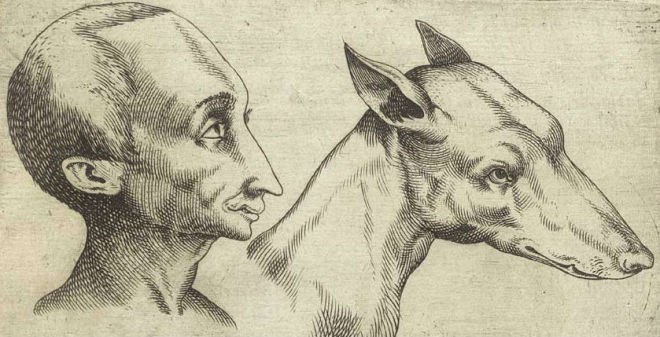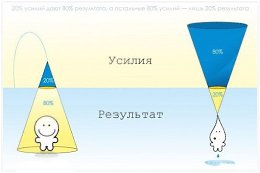
Fantastically Wrong: The Silly Theory That Almost Kept Darwin From Going on His Famous Voyage
According to the theory of physiognomy, this man in Giambattista della Porta’s De Humana Physiognomonia would behave like a dog because he looks like one. Kinda like Teen Wolf, only without the sick Ray Bans. Library of Congress
The other day I had what could be considered a bit of an … overreaction. On a crowded train during my morning commute to WIRED there was an old lady who looked kinda mean sitting with her purse splayed on the seat next to her. What a savage, I thought, someone should put her in a home. OK, I wasn’t serious, and there are of course worse offenses in the world, but in retrospect, what was interesting and admittedly kind of rotten about my reaction was that I judged her by her looks. She had a droopy face and downturned mouth, so clearly she must be miserable and mean.
It’s patently silly, but in a way it isn’t. We’re evolutionarily programmed to read our peers’ faces. For instance, a scowling, red-faced raging person is probably best avoided, if not getting roughed up is in your best interest. Good judgement could mean the difference between falling victim to a dangerous character and rightly keeping your distance and escaping unharmed. Not that I was afraid of the old lady. I want to be very clear about that.
A couple thousand years ago some folks were apparently so worried about all this that they thought up a little something called physiognomy—the “art” of reading a human’s personality in their face. Bird-like features meant a bird-like personality, and by using this system you could figure out who to avoid without even speaking to them. But this was no fringe movement: Charles Darwin himself was judged by the physiognomist captain of the Beagle and nearly barred from the voyage. And if you can believe it, there are still physiognomists out there practicing this bunk and charging people for it, making outrageous claims like you can tell if a person is wealthy or not by their nose (I’m not kidding—oh how I wish I were kidding). Weirdly, though, there may be a tiny bit of truth to ascribing certain personality traits to certain physical traits.
It was the ancient Greeks who pioneered the practice of physiognomy. None other than Pythagoras apparently “‘physiognomized’ the young men who presented themselves for instruction,” wrote the Roman writer Aulus Gellius, meaning that he inquired “into the character and dispositions of men by an inference drawn from their facial appearance and expression, and from the form and bearing of their whole body.”
The idea was that if you looked like an animal, say, a sheep, you also had its personality. And according to Jodie Jenkinson in her essay “Face Facts: A History of Physiognomy from Ancient Mesopotamia to the End of the 19th Century,” the theory “served a dual purpose, providing a measure for diagnosing illness and delineating character, as well as establishing a method for divination”—that is, predicting someone’s future—“based on physical appearance.”
Physiognomy was practiced here and there in Europe in the Middle Ages, but it wasn’t until the 16th century that the practice really blew up. For this we can thank the Italian polymath Giambattista della Porta, who according to Jenkinson legitimized physiognomy “as the product of natural science.” In his book De Humana Physiognomonia, della Porta presented often quite beautiful illustrations of humans and the animals they resembled side-by-side. The features of both parties tended to be wildly exaggerated to prove a point, and indeed Jenkinson considers the drawings to be one of the earliest forms of caricature in human society.
Mercifully, physiognomy was widely discredited by the end of the 1600s. But that didn’t stop a few rogue characters from continuing to explore it. In the 18th century a pastor named Johann Casper Lavater wrote a massive four-volume work on physiognomy, arguing that “one could better love one’s neighbor by classifying him according to his facial features.” For Lavater, who was apparently never told that it’s what’s inside that counts, physical beauty was an indication of moral beauty. He figured you could also read the wrinkles and creases in someone’s face, much like a psychic would read your palm.
Taking this one step further, the criminologist and accomplished racist Cesare Lombroso argued that you could pick a criminal out of a crowd by analyzing their features. Indeed, he argued criminals were evolutionary throwbacks, closer to apes than humans. By comparing them to “savages” around the world, you could tell if they were liable to fall into a life of crime. Just a few of the things to watch out for: “oblique eyelids, a Mongolian characteristic”; “the projection of the lower face and jaws (prognathism) found in negroes”; and of course noses with a “tip rising like an isolated peak from the swollen nostrils, a form found among the Akkas, a tribe of pygmies of Central Africa.”
And physiognomy even came damn close to altering the course of human history. Charles Darwin very nearly didn’t sail on the now-famous voyage of the Beagle—which informed his theory of evolution by natural selection—because the ship’s mercurial captain, Robert FitzRoy, didn’t like Darwin’s nose. “He was an ardent desciple [sic] of Lavater,” Darwin later wrote, “and was convinced that he could judge a man’s character by the outline of his features; and he doubted wheather [sic] anyone with my nose could possess sufficient energy and determination for the voyage. But I think he was afterwards well-satisfied that my nose had spoken falsely.”
You’d think that with such a rotten track record, physiognomy would be extinct today—and you’d be wrong. Take, for instance, the dazzling display of delusion embedded below. Not only does a physiognomist seriously suggest on national TV that you can judge character based on facial features, but that you can use physiognomy to determine how wealthy a man is before you start dating him. “The nose is the key,” she says. “And the larger the nose, the more spiritual or financial abundance. Mother Teresa of Calcutta for example had a huge nose.” I couldn’t make this up, folks.
According to the theory of physiognomy, this man in Giambattista della Porta’s De Humana Physiognomonia would behave like a dog because he looks like one. Kinda like Teen Wolf, only without the sick Ray Bans. Library of Congress
The other day I had what could be considered a bit of an … overreaction. On a crowded train during my morning commute to WIRED there was an old lady who looked kinda mean sitting with her purse splayed on the seat next to her. What a savage, I thought, someone should put her in a home. OK, I wasn’t serious, and there are of course worse offenses in the world, but in retrospect, what was interesting and admittedly kind of rotten about my reaction was that I judged her by her looks. She had a droopy face and downturned mouth, so clearly she must be miserable and mean.
It’s patently silly, but in a way it isn’t. We’re evolutionarily programmed to read our peers’ faces. For instance, a scowling, red-faced raging person is probably best avoided, if not getting roughed up is in your best interest. Good judgement could mean the difference between falling victim to a dangerous character and rightly keeping your distance and escaping unharmed. Not that I was afraid of the old lady. I want to be very clear about that.
A couple thousand years ago some folks were apparently so worried about all this that they thought up a little something called physiognomy—the “art” of reading a human’s personality in their face. Bird-like features meant a bird-like personality, and by using this system you could figure out who to avoid without even speaking to them. But this was no fringe movement: Charles Darwin himself was judged by the physiognomist captain of the Beagle and nearly barred from the voyage. And if you can believe it, there are still physiognomists out there practicing this bunk and charging people for it, making outrageous claims like you can tell if a person is wealthy or not by their nose (I’m not kidding—oh how I wish I were kidding). Weirdly, though, there may be a tiny bit of truth to ascribing certain personality traits to certain physical traits.
It was the ancient Greeks who pioneered the practice of physiognomy. None other than Pythagoras apparently “‘physiognomized’ the young men who presented themselves for instruction,” wrote the Roman writer Aulus Gellius, meaning that he inquired “into the character and dispositions of men by an inference drawn from their facial appearance and expression, and from the form and bearing of their whole body.”
The idea was that if you looked like an animal, say, a sheep, you also had its personality. And according to Jodie Jenkinson in her essay “Face Facts: A History of Physiognomy from Ancient Mesopotamia to the End of the 19th Century,” the theory “served a dual purpose, providing a measure for diagnosing illness and delineating character, as well as establishing a method for divination”—that is, predicting someone’s future—“based on physical appearance.”
Physiognomy was practiced here and there in Europe in the Middle Ages, but it wasn’t until the 16th century that the practice really blew up. For this we can thank the Italian polymath Giambattista della Porta, who according to Jenkinson legitimized physiognomy “as the product of natural science.” In his book De Humana Physiognomonia, della Porta presented often quite beautiful illustrations of humans and the animals they resembled side-by-side. The features of both parties tended to be wildly exaggerated to prove a point, and indeed Jenkinson considers the drawings to be one of the earliest forms of caricature in human society.
Mercifully, physiognomy was widely discredited by the end of the 1600s. But that didn’t stop a few rogue characters from continuing to explore it. In the 18th century a pastor named Johann Casper Lavater wrote a massive four-volume work on physiognomy, arguing that “one could better love one’s neighbor by classifying him according to his facial features.” For Lavater, who was apparently never told that it’s what’s inside that counts, physical beauty was an indication of moral beauty. He figured you could also read the wrinkles and creases in someone’s face, much like a psychic would read your palm.
Taking this one step further, the criminologist and accomplished racist Cesare Lombroso argued that you could pick a criminal out of a crowd by analyzing their features. Indeed, he argued criminals were evolutionary throwbacks, closer to apes than humans. By comparing them to “savages” around the world, you could tell if they were liable to fall into a life of crime. Just a few of the things to watch out for: “oblique eyelids, a Mongolian characteristic”; “the projection of the lower face and jaws (prognathism) found in negroes”; and of course noses with a “tip rising like an isolated peak from the swollen nostrils, a form found among the Akkas, a tribe of pygmies of Central Africa.”
And physiognomy even came damn close to altering the course of human history. Charles Darwin very nearly didn’t sail on the now-famous voyage of the Beagle—which informed his theory of evolution by natural selection—because the ship’s mercurial captain, Robert FitzRoy, didn’t like Darwin’s nose. “He was an ardent desciple [sic] of Lavater,” Darwin later wrote, “and was convinced that he could judge a man’s character by the outline of his features; and he doubted wheather [sic] anyone with my nose could possess sufficient energy and determination for the voyage. But I think he was afterwards well-satisfied that my nose had spoken falsely.”
You’d think that with such a rotten track record, physiognomy would be extinct today—and you’d be wrong. Take, for instance, the dazzling display of delusion embedded below. Not only does a physiognomist seriously suggest on national TV that you can judge character based on facial features, but that you can use physiognomy to determine how wealthy a man is before you start dating him. “The nose is the key,” she says. “And the larger the nose, the more spiritual or financial abundance. Mother Teresa of Calcutta for example had a huge nose.” I couldn’t make this up, folks.






Следующая запись: Если бы «мстители» мстили в Fantasy
Лучшие публикации